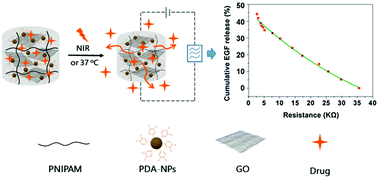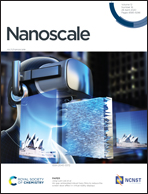Temperature/near-infrared light-responsive conductive hydrogels for controlled drug release and real-time monitoring†
Abstract
Stimuli-responsive hydrogels with adaptable physical properties show great potential in the biomedical field. In particular, the collection of electrical signals is essential for precision medicine. Here, a simple strategy is demonstrated for achieving controlled drug release and real-time monitoring using an interpenetrating binary network consisting of a graphene aerogel and a poly(N-isopropylacrylamide) hydrogel with incorporated polydopamine nanoparticles (PDA-NPs). Owing to the good physical properties of graphene and the embedded PDA-NPs, the hybrid hydrogel shows enhanced mechanical properties and good electrical conductivity. In addition, the hybrid hydrogel also shows dual thermo- and near-infrared light responsiveness, as revealed by the controlled release of a model drug. In addition, as the hydrogel exhibits detectable changes in resistance during drug release, the drug-release behavior of the hydrogel can be monitored in real time using electrical signals. Moreover, owing to the abundance of catechol groups on the PDA-NPs, the hybrid hydrogel shows good tissue adhesiveness, as demonstrated using in vivo experiments. Thus, the developed hybrid hydrogel exhibits considerable practical applicability for drug delivery and precision medicine.



 Please wait while we load your content...
Please wait while we load your content...